The soul of the sixties. The first retrospective of Alla Gorska was opened in “Ukrainian House”.
[ad_1]
Nowadays, the need for memory often becomes felt after tragic events. It is they who bring us back to important events and figures. The anniversaries of the Maidan, the occupation of Crimea or the exit of defenders from the Donetsk airport become days of remembrance and encourage us to delve into what happened in those days. For us, the destruction of numerous cultural monuments by the Russians turns into a search for information about destroyed museums, archives, and concert halls. The map of air alarms made it possible to remember the location of each Ukrainian region.
So in July 2022, Russians will be in Mariupol destroyed two mosaic panels Alla Gorska. Most of the mosaics have been preserved, but due to the occupation of the city, their fate is now unknown. Alla Gorska was also killed by Russia, so the terrorist country continues to destroy and remain unpunished for it.
One of the ways to fight the destruction in Ukrainian culture is not to give an opportunity to forget about it. “Ukrainian House” is organizing the first major retrospective of Alla Gorska “Boryviter” to show her as an artist and activist with a powerful inner strength that we all need now.
It is hard to imagine a better place for the exhibition about Alla Gorska than “Ukrainian House”. The monumentality of the building, its colored stained-glass windows and marble halls resonate with the scale of the artist’s personality and her work.
“Boryviter” opens an annual exhibition program in the “Ukrainian House” and exhibits more than 100 works of Gorska. Among them are paintings, graphics, sketches of her monumental and mosaic works. More than 10 museums and archives, as well as many private collectors, shared the works of the artist to make the retrospective possible. In a full-scale war, when there is a constant threat of shelling and destruction, such efforts of cultural institutions deserve special respect.
Alla Gorska’s painting
The exhibition itself was prepared for about a year, based on preliminary research by the Dukat Art Foundation team. Member of the curatorial group Olena Grozovska says that the main tasks were to consider the past, and to direct it to the present, to reveal this connection: “We wanted to show Gorska as an artist with an extraordinary range: these are theatrical works, and monumentalism, and painting, and graphics. Among these, it was extremely important for us to talk about the historical context of those events leading up to the present. And these are not only tragic stories, but a powerful network of human solidarity, which was formed among the sixties, who became the basis of civil society. We remember them, thinking about the future and hoping for victory“.
The exhibition itself really looks like an invitation to the light of the sixties, whose engine is Alla Gorska. As if the Club of Creative Youth, created by the artist in 1960, has continued its activities and now gathers everyone who cares to discuss art and politics.

Alla Gorska at work
At the beginning of the exhibition, the 60s are immediately combined with modernity: we see sketches of two mosaic panels – “Tree of Life” and “Kestrel”, created for the restaurant “Ukraine” in Mariupol. Next to the sketches are photographs of mosaic fragments destroyed by the Russian occupiers at the beginning of the full-scale invasion. History continues, and its time ceases to be purely past or purely present.
We go up the stairs and see a chronological tape on the wall that takes us from the birth of Alla Gorska to her death. During the entire exhibition, you will not be left with the feeling that Alla is walking with you, invisibly present in the halls, and talking about herself. Therefore, actually, everything begins with acquaintance. At the opening of the exhibition, Alla Gorska’s granddaughter notes that the exhibition will appeal to both those who want to learn more about the figure of the sixty-year-old woman and those who are completely unfamiliar with her.
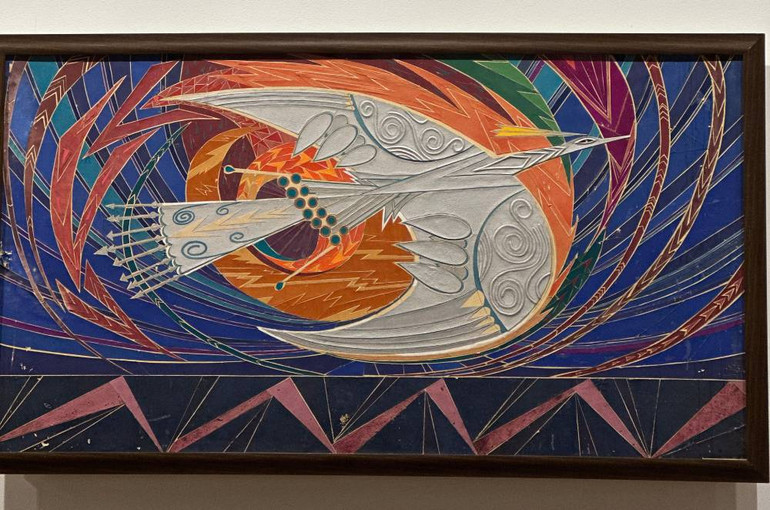
Prototype mosaic panel “Boriviter”
On the first floor there are two halls – “Mosaic” and “Theatre”. In the development of mosaic panels, it is noticeable how important the community is: the authorship of the sketches could belong to Alla, and several of her colleagues embodied them at once. Among them are her husband Viktor Zaretskyi, artists Hryhoriy Sinytsia, Halyna Zubchenko, Borys Plaksii. In addition to smalt and ceramic tiles, which were considered traditional materials for mosaics, artists also used atypical materials: glass, dishes, waste from the metallurgical production of “Azovstal”.

Sketches for theatrical performances
Through the mosaic works, the geography of the artist’s paths appears: in Kyiv, she creates a composition “Wind” on the facade of the Vitryak restaurant; in Zhdanov (the then name of Mariupol) – a panel “Blooming Ukraine” for “Kyiv” deli; in Donetsk – a mosaic panel for experimental school No. 5. Sketches created with pencil or ink, where you can see every line, also add to the effect of Gorska’s presence here and now.
Next to the mosaic sketches are photos and quotes from Alla herself and her colleagues. For example, Borys Plaksii shares that the artists worked on “Vitryak” in particularly difficult conditions, and “no female artist could withstand such conditions”: “First, terrible rains, and then frosts and winds. In half an hour, the hands with which you take the cement mortar become like a rake.” But Gorska mocks her husband: “Zaretsky is a good fellow – he begins to think as a whole… Finally, he solves the entire wall in its total volume, and not just the hero’s nose“.
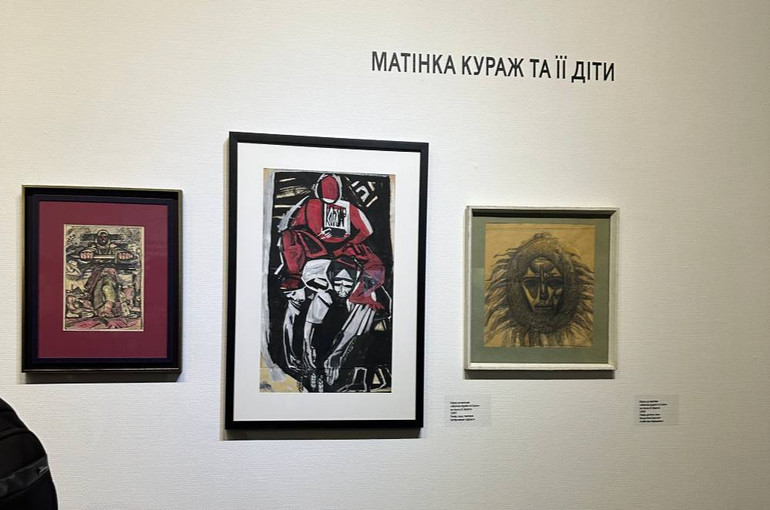
Sketches for performances
Theater is not the first industry that is mentioned when Gorska is mentioned, although the artist masterfully developed sketches for plays of Ukrainian and world classics. Her costumes are those dynamic geometric shapes that the curators of the exhibition mention from time to time in their texts.
In the early 1960s, Alla Gorska developed artistic designs for performances “Mother Courage and her children” according to the play Bertold Brecht, “Knife in the Sun” according to the poem Ivan Drach, “Pathetic Sonata” and “This is how Huska died” by plays Mykola Kulisha, “Truth and wrong” according to the novel Mykhailo Stelmakh. Some of these performances were banned, and therefore, Gorska’s scenographic ideas remained unrealized.
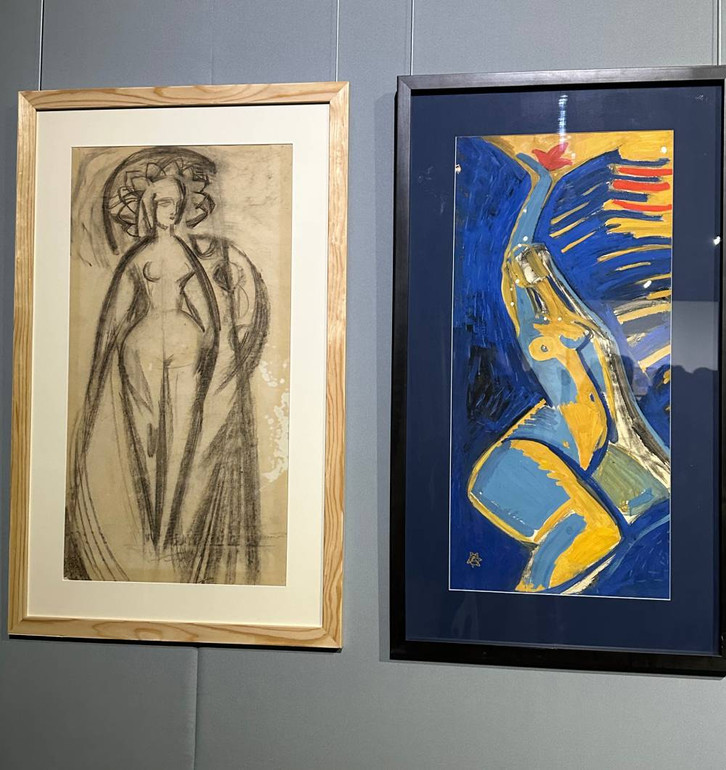
Sketches for performances
The next, last floor of the exhibition is an opportunity to trace the development of Gorska’s artistic practice. Her figure becomes more individualized and stands out among her sixties colleagues. On this floor – famous “Self-portrait with son” 1960, a number of self-portraits of Gorska, created in different years, as well as the faces of those artists who surrounded her or whom she was interested in. Artists appear on canvases Forest Tanyukwith whom they worked in the theater section of the Creative Youth Club “Contemporary”, poets Taras Shevchenko, Ivan Svitlichnyi, Ivan Drachlinguist Boris Antonenko-Davydovych.
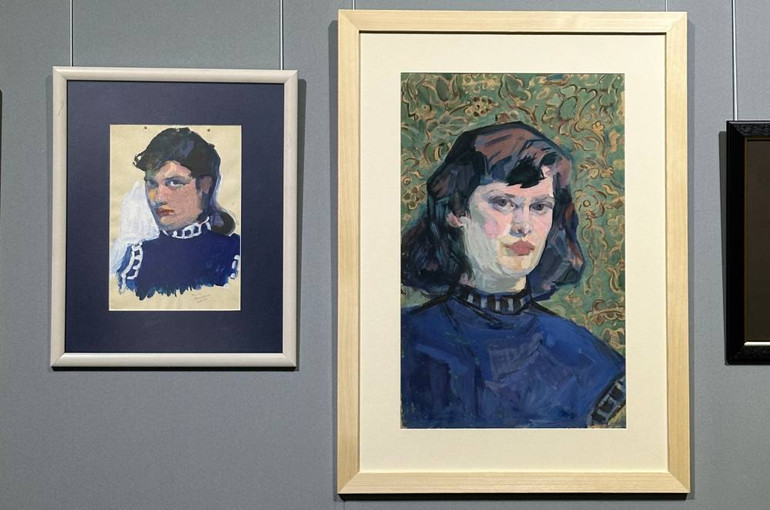
Self-portraits of Alla Gorska
Among the numerous linocuts created by Alla is a sketch of the cover of a poetry collection Lina Kostenko “Star Integral”. Among the works are photographs from the collections of “Contemporary”, quotes by the artist from letters to like-minded people, as well as large canvases with her handwriting. On some she draws sketches, on others she shares her thoughts about the creative process, and we observe a kind of visual diary, which also presents Gorska in modern times. Together with her experiences, fears, aspirations.
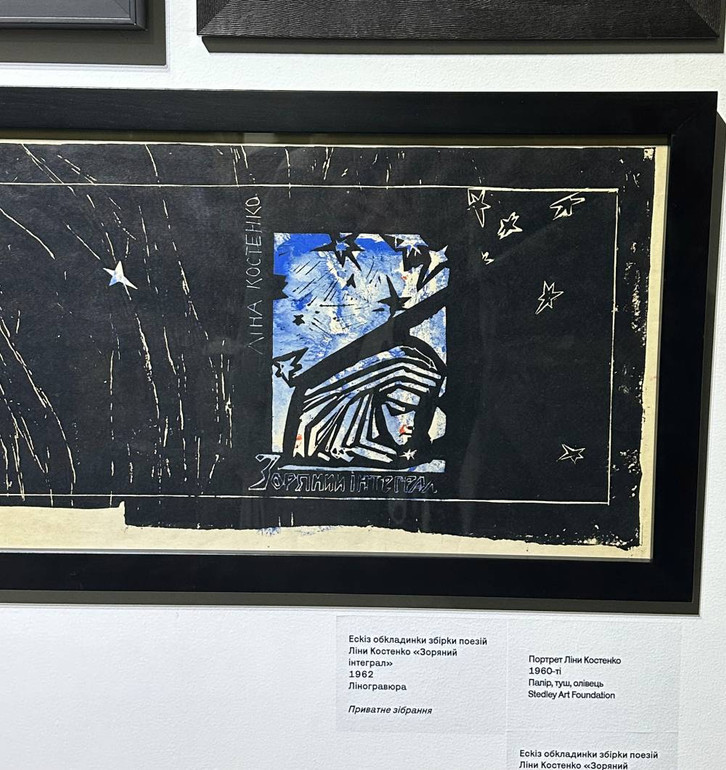
Sketch for the collection “Star Integral”
One of the important sections of the exhibition is the creation of a stained glass window for the red building of Kyiv National University. According to the layout, in the center of the composition was supposed to be an angry Kobzar, who hugs a Ukrainian woman with one hand and holds a book with the other, with the words: “I will magnify these little dumb slaves, I will put the word on the watch over them“. By order of the party leadership, the stained glass window was destroyed, because its images in no way resonated with the Soviet authorities.
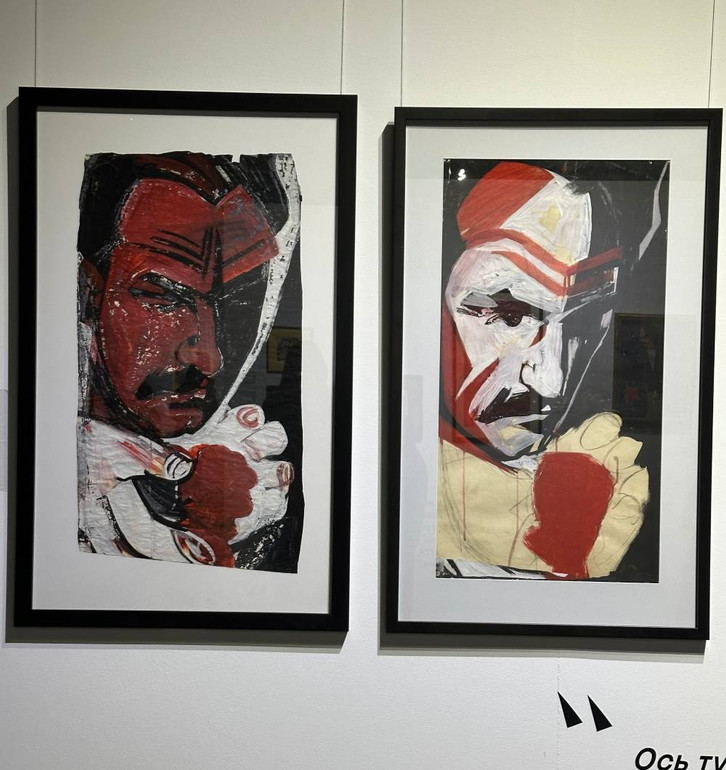
Portraits of the poet Ivan Svitlychny
The gravity of Ukrainian art at the exhibition helps to trace the works of other artists who had a direct influence on the practice of Alla Gorska. It Hanna Sobachko-Shostak, Oleksandr Sayenko, Maria Prymachenkowho also elaborated the traditions of folk art in different ways.
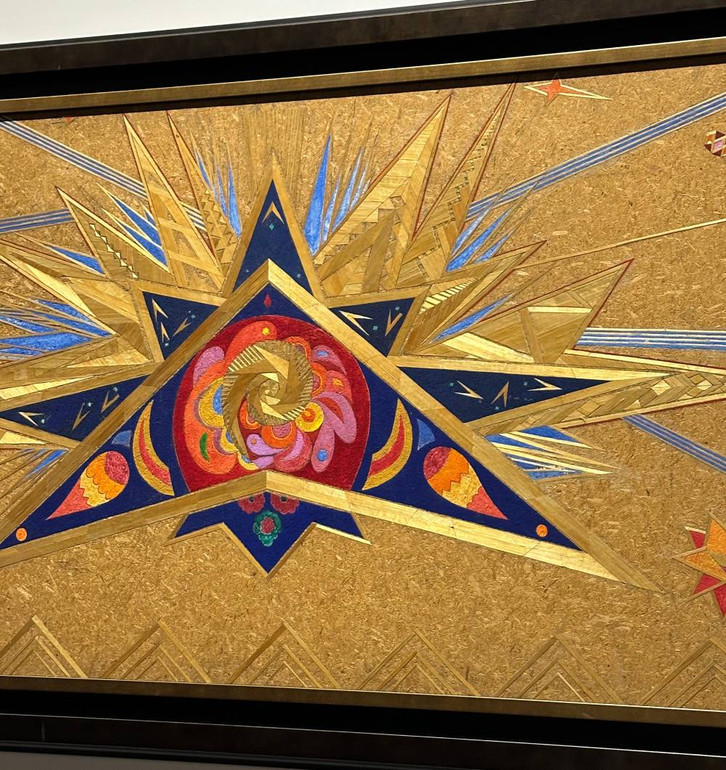
“Fiery Flower”
The last two halls clearly stand out from the others. They are made in monochrome colors and resemble spaces of commemoration, memory, and sorrow. These are the halls “Bykivnya” and “Murder”.
Together with Vasyl Symonenko and Les Tanyuk, Alla Gorska finds the burial places of people shot by Enkavedists in the 1930s in the Bykivnyansky forest. The hall is made of black canvases, which show the memories of the artists during the search: Alla “sweared like a hundred cholera” after what she saw, Tanyuk noticed boys playing football with a human skull. Buttons from the clothes of the shot victims are laid out under the glass display case.

Photos
For the Soviet authorities, this becomes the final push to liquidate Gorska. In the last hall, documents of the Main Committee of the Communist Party were placed, in which it was noted that Alla’s friends were planning to stage a provocation during her burial. There is also a list of those who attended the funeral and the reasons why they came. The methodical click of a typewriter sounds in the background.
The exhibition seems voluminous and full, but it passes quickly, just like Gorska’s life. 41 years is very short for the scale of such a legacy left by the artist.
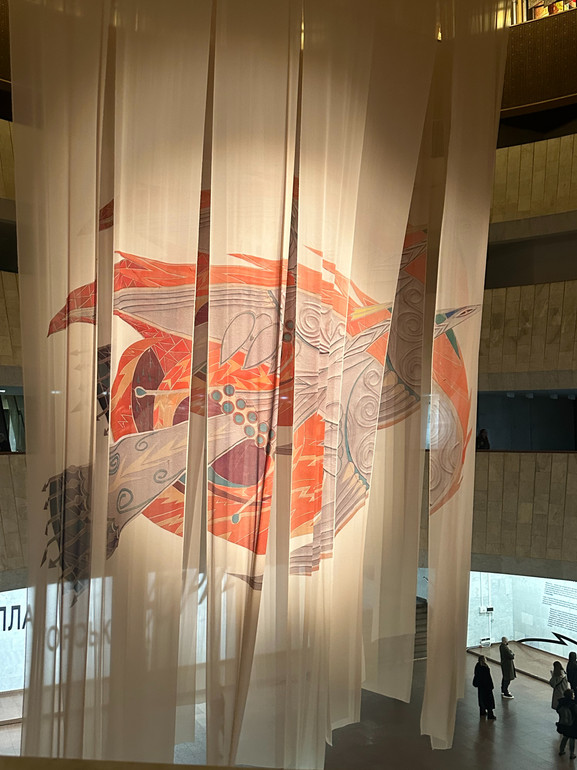
“Boriviter” installation
You have to be in the space of “Borivitru” – walk slowly, read, reflect, discuss. To notice how much everything responds, how any time limit between years is erased. Gorska’s granddaughter Olena Zaretska says: “In recent years, I have received incredible support from Alla Gorska, both as a grandmother and as a person, when I myself am going through an acute period of self-identification. It is much easier for me to endure all the trials, knowing that someone has already gone through this pathWe still have a lot to do to make these names sound as loud as they should be.
If you look up, you can see how the canvas “Boriviter” stretches from top to bottom of the building. Despite all the destruction, oppression and silencing, he flies.
[ad_2]
Original Source Link











